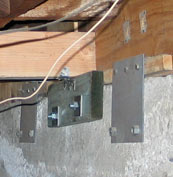Is Your Home Safe?
In California, earthquakes are a major threat to the safety and well-being of residents. Over the years they have caused billions of dollars in property damage as well as thousands of injuries and deaths.

According to the California Seismic Safety Commission’s “The Homeowner’s Guide to Earthquake Safety,” many homes have common weaknesses that can result in damage during a quake. These weaknesses include a home that isn’t anchored to its foundation, unbraced water heaters, weak cripple walls, homes built on pier and post foundations, unreinforced masonry foundations, or steep hillsides; and homes with unreinforced masonry walls or rooms over garages.
When a home isn’t bolted to its foundation, it can slip off and even collapse during a quake. The damage can be so severe that the home needs to be torn down. This potentially dangerous situation can be fixed with house bolting – anchoring the home to its foundation.
A foundation can also become weak over time due to the materials used in its construction, soil or water issues. The chances of damage from an earthquake are much higher when there is any type of pre-existing foundation problems.
A water heater is considered properly braced when it has two straps that wrap completely around it and are screwed into the studs or masonry of the wall. Water heaters that aren’t braced can fall over during a quake, causing broken water and gas lines, and fire from gas leaks.
Cripple walls can be strengthened by adding braces. When a quake hits, the braces will help prevent wall movement and collapse.
Pier and post foundations can fall over during a quake if they are not well-supported. There are various ways to strengthen these types of foundations, including bracing.
An earthquake can also easily damage foundations made of concrete, brick or stone, in addition to masonry walls and chimneys. Reinforcement can prevent cracks, sliding, slipping and collapses during a quake. House leveling ahead of a quake can minimize damage.
The support structure for houses built on hills can also be strengthened with bracing and other types of support.
Many times the walls supporting a room built over a garage aren’t strong enough to support the weight of the addition. Without additional support or reinforcement, the walls can tip over.
When a structure isn’t properly braced or supported, earthquake damage can also include floor, wall and window damage; damage to personal items within the house, broken gas and utility lines, fire (from broken gas lines), in addition to physical injuries to the home’s occupants.
The CSSC recommends earthquake retrofitting, which it states is “relatively cheap” compared to “doing major structural repairs to your home after an earthquake.” If you look at how much does foundation repair cost, it’s a worthwhile investment. The CSSC also notes that “After an earthquake, there is usually a shortage of available licensed contractors and engineers in the impacted area, because of the sudden high demand for their services.”
If you believe your home has structural weaknesses, you should get a foundation inspection (Los Angeles and in other earthquake prone areas) by experienced foundation contractors. Foundation issues are best addressed by a foundation repair expert who has an extensive history of working on homes throughout your area. Retrofitting your home can minimize the damage from a quake and prevent injuries.
About the author:
Shawn Kyles, expert in foundation repair & house bolting at Julian Construction (www.julianconstruction.com) in Los Angeles, has inspected over 15,000 structures for building & safety.
See their video:





